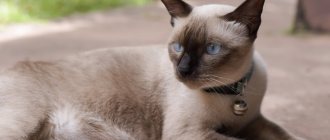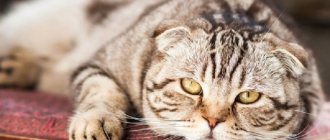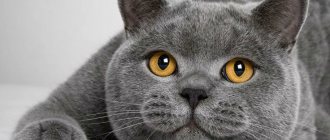Character
The Persian cat is one of the most suitable for living in a family.
This breed is unlikely to survive in the wild. She is sociable: she gets along well with children, even the capricious and annoying ones. Falls in love with the owner once and for all: protects, heals and “worries” about the person. Persians are incredibly in need of love and affection, so they happily endure trips and relocations next to their beloved owner. While its owner is away, the Persian cat “freezes”: it may not touch food or drink, or even leave one place. But when someone from the family crosses the threshold, the pet literally comes to life! This breed takes care of its offspring like no other. Moreover, the Persian cat considers the owner to be “involved” in pregnancy and childbirth: while bearing offspring, she constantly shares her experiences with you, and after giving birth, she is sure that you must care for the cubs together - feed, play and lull the babies “in four hands.” However, the cat is simply torn between the need to be with her beloved owner and maternal duty
Conclusion: a pregnant and lactating Persian cat needs to be surrounded with even more attention and love. Temperament varies among Persians, but they are not aggressive. Persian kittens are always funny and restless, and they remain that way for many years if a person supports the cat’s playful behavior
In any case, this breed will never “talk back” to a person, calmly withstanding all the squeezing and hooting directed at it.
For “connecting” to the owner’s problems, the Persian cat often pays with a weak immune system.
Persians are a rather naive and curious breed. Therefore, they need special living conditions, such as:
- remove all medications and chemicals;
- When cooking, make sure that your pet does not jump onto the stove or hot dishes;
- check the washing machine and dryer - the cat can easily fall asleep there;
- Provide the windows with high-quality nets – this breed loves to sit on the windowsill.
Wool
Caring for the hair of a Persian cat is an entire art that requires special means and consistent actions.
Combing your pet takes place in several stages: we go over it with a thin comb, then carefully comb it with a medium comb and smooth it with a fine brush. Frequency – once every 2-3 days.
Conditioner or spray can be used during or at the end of the procedure, they will give your Persian's coat a healthy look and shine. Don't forget about cat antistatic agents.
It's time to find out what a Siberian cat is like - the character and other interesting features of the breed - under the picture.
And this article will teach you how to recognize and treat worms in domestic cats.
All about tablets for deworming in cats https://kotovasia.net/...79.html
Bathe your animal once every 2-3 weeks with a quality shampoo for long-haired cats.
After water treatments, pat the coat dry with a towel and gently comb it until completely dry, naturally, in a warm room.
Persian cats should be trimmed without touching the tail. But remember that you cannot cut colorpoint Persians to avoid pigmentation.
Nutrition
What to feed a Persian cat is one of the most important issues in keeping the breed. Ideally, you need to equally combine good food with homemade food:
- almost half of the diet is proteins (lean meat, fish, dairy, soybeans);
- carbohydrates (cereals, bread, root vegetables, oatmeal);
- necessary vitamins (olives, asparagus, boiled or raw vegetables, fruits).
The main thing is to keep seasonings and spices out of your cat’s diet.
A Persian can catch mice if this instinct is awakened in the kitten from 3 to 6 months.
Diseases
The Persian is a cat breed with fairly good health, but they have several hereditary diseases, for example:
- polycystic kidney disease;
- blindness (manifests by 4-8 weeks, after a couple of months the animal becomes completely blind);
- excessive tearfulness of the eyes due to a flat muzzle (need eye care - blotting with a napkin, treating with a special lotion);
- hypertrophic cardiomyopathy;
- Persian cats are also susceptible to gingivitis, the formation of tartar and plaque.
Your pet should be checked by a veterinarian every few months.
Kidney failure in cats and life expectancy
How long a pet will live is influenced by its predisposition to various diseases. Every owner strives to do everything so that his pet lives as long as possible. However, at an advanced age, felines can develop diseases that were not so common before. Such ailments include chronic renal failure.
Today, approximately 30% of cats suffer from kidney failure. About 20 years ago, this disease occurred only in a few, but now it affects more and more pets. Chronic renal failure is a disease that doctors cannot yet cope with. Veterinarians are not yet able to restore health to a pet and make its life fulfilling.
If previously cats died at the age of 10-13 years, then in the modern world, on average, domestic cats live about 18-23 years. Such pets are considered long-livers in the animal world. However, longevity also has a flip side to the coin. An increase in the number of pets developing kidney failure is associated with an improvement in the quality of life and its duration.
How long cats can live at home with kidney failure depends on how badly the kidneys are damaged. The larger the affected area, the more difficult it is to cure the disease. If the owner did not notice a deterioration in health in time, and the pet was taken to the veterinarian with an advanced disease, then most likely the pet will die a month after the disease was discovered.
Timely identification of symptoms and compliance with doctor’s instructions can prolong the life of a cat with renal failure (in chronic form) to the average life expectancy: 10-13 years.
It turns out that this disease is more common in cats of a certain breed, for example, British or Persian. This is due to their predisposition to a congenital anomaly - polycystic kidney disease. This, in turn, leads to kidney failure.
As a preventive measure, doctors recommend periodically showing pets to veterinarians and doing clinical and biochemical blood tests: creatinine, urea, protein, potassium, phosphorus. You also cannot do without a general urine test. Thanks to laboratory tests, the veterinarian will be able to track the failure of the cat’s kidneys and prescribe supportive therapy.
The breed got its name from the place where long-haired cats were first mentioned: Persian beauties were first described by Europeans in 1400. Later, in 1620, the first, presumably, Persian beauties were brought to Italy by a famous traveler. However, debates about the types of eastern longhaired cats are still going on. Only one thing is known: there were several species. Someone mentioned graceful and thin beauties with long hair, described as similar to. Others, like Alfred Brehm, spoke of large and strong animals. The long hair turned out to be a mystery: the eastern regions have a rather mild climate, and the native breeds should be short-haired. The hair of the Persians is more suitable for the Siberian cold - therefore, a version arose about the East Siberian origin and subsequent migration to the south. This version is confirmed by the external resemblance of the long-haired beauties to the wild Pallas cat.
Story
Since its inception, the Persian cat has been listed among the highest rank breeds. Traveling in the Middle Ages along with expensive goods, she ended up in the homes of the noble classes, securing the title of the most prestigious domestic cat.
In 1620, the Persians were first mentioned in documents - the travel letters of P. dela Valle indicate the import of four pairs of long-haired cats from Iran to Italy. Unfortunately, their further fate is unknown.
Then the history of the Persian breed acquires quite a wide resonance:
- At the beginning of the 17th century, the astronomer N. de Pieresque brought a pair of long-haired cats from Ankara to France, which were called “Angora”. Pieresque became one of the first breeders of modern Persians. The ancestors of the breed only vaguely resembled today's Persian cat, on whose appearance and character felinologists have worked for centuries. However, one of the versions of the origin is the symbiosis of long-haired Iranian cats and Turkish Angora.
- Iranian scientists have a different opinion. They believe that the Persian breed originates from the steppe cats that still live in Africa and Asia.
- Some felinologists adhere to another hypothesis: the ancestor of the Persians is the wild cat Manul.
There is no definite version, but, one way or another, Persian cats from the East came to Europe, and then to England, where they were taken seriously.
Who are the Abyssins? Click on the picture to expand your horizons.
Live toy kitten. How this is possible - read in this article.
In 1887, the "Persian Longhair" was registered in the British Breed Book.
Since then, breeders have improved the breed:
- the rectangular body has become more compact;
- the head is rounder and more massive;
- the eyes became slanted;
- ears - more widely set;
- the muzzle acquired a “childish” expression.
At the end of the 19th century, Persian cat nurseries appeared in the USA, Russia, Italy, France and other countries.
Factors influencing the health and life expectancy of Persian cats at home
In the mid-twentieth century, the Persian breed was overtaken by an unknown genetic mutation. Their already short snub noses became even smaller. Representatives of this branch were called “Peking”, although international felinological associations did not change the standard. They simply did not oppose the appearance of animals with new parameters at exhibitions and considered them the result of the natural development of the classic Iranian breed.
As a result of selection, three species of Persian cats were formed, in which the size, shape and position of the nose became the main distinguishing feature.
- In the classic group, a small straight nose is located below eye level.
- The European population reduced this part of the muzzle, introduced a snub nose and raised the nose in line with the lower eyelid.
- Extreme type - the nose rises to the upper edge of the eye.
It was later discovered that the lifespan of flat-faced Persian cats in domestic environments had decreased and they were developing health problems that had not previously existed.
- Shortness of breath and difficulty breathing - sometimes this symptom greatly worries the owners of Persian cats living at home. You have to urgently contact a veterinarian and constantly monitor the animal’s condition.
- Entropy – usually affects the lower eyelid, which folds inward. In this case, the cilia can rub and damage the cornea of the eye, causing injury, causing pain and infection.
- Another symptom that leads to similar consequences is trichiasis of the upper eyelid or nasal fold. Here the hair grows so close to the eye that it irritates the pupil and causes damage.
- Difficult childbirth - dystocia. It occurs quite often in the lives of domestic cats. The birth of dead offspring in the breed is now at the level of 16-22%.
Other diseases that affect the lifespan of Persian cats in the home are more common among other animals and are common to all breeds.
- The appearance of multiple cysts in the kidneys or polycystic disease (PKD) is a genetic disease that is expressed in the development of structural abnormalities of the renal tubules and the formation of cysts. At the end of the last century, pathology was diagnosed in half of the animals aged 3 to 10 years, which significantly shortened the lifespan of Persian cats at home. Thanks to the movement of animal activists, these catastrophic statistics were corrected. Most reputable breeders do DNA tests on animals and only breed those that do not have the PBP gene responsible for transmitting the disease.
- Cardiomyopathy is the inability of the heart muscle to pump blood normally due to thickening of the left chamber wall. The disease often leads to sudden death. It greatly affects how long castrated Persian cats live. After surgery, such animals are prone to gaining excess weight, which causes additional stress on the cardiovascular system. In some breeds (Maine Coon, American Shorthair), the genetic nature of this disease has been confirmed, but experts have also added Persian cats to this list.
Other illnesses are not so fatal, but they can also cause great anxiety for animal owners and take up time for treatment.
- Incorrect bite and inability to chew food normally.
- Reduced sensitivity level in the thermal protection area.
- Sebaceous adenoma is a slowly growing tumor on the skin of a Persian cat.
- Lupus erythematosus is a malfunction of the cat’s immune system.
- Various types of dermatological diseases associated with the anatomy of the muzzle in Persian cats.
Standard
There are 3 officially recognized standards for Persian cats. Today, the European standard is the most common, while the exotic has the most distinctive appearance and corresponding price.
The types differ only in the shape and location of the nose:
- Old English - straight nose located just below the eyes.
- Modern European Persian - the upper edge of the nose is at the level of the lower eyelids.
- Extreme (exotic Persians) – the nose is raised even higher, to the inner corner of the eye.
Otherwise the standards are similar:
- powerful, large or medium body;
- fairly large, round head;
- small, wide-set, slightly rounded ears;
- round, large and expressive eyes;
- the neck is strong, from short to medium length;
- short, powerful limbs;
- short, fluffy, “down to earth” tail;
- long, thick, shiny coat, reaching 20 cm in length.
Male Persians reach a weight of 7 kg, females are usually 2-3 kg lighter.
Colors
A hundred colors for one breed is, of course, a lot. Therefore, felinologists here also rank the Persian breed based on eye color.
- Yellow-eyed. In turn, there are two types of colors of yellow-eyed Persian cats - simple and complex. In simple, the color of the guard and undercoat is the same. Usually these are white, red, black and tortoiseshell cats. In complex cats, they vary: the undercoat is lighter. This color is formed from smoky or tabby, for example, silver tabby is one of the most beautiful options for a Persian fur coat.
- Green-eyed. In this group of cats, there are only complex colors, such as shaded silver or chinchilla.
- Blue-eyed. The peculiarity of this type is its bright markings on a light background of fur, that is, all varieties of Persian cats are color point. The colors of blue-eyed Persians are the most diverse, including tabbed and silver.
The most common colors of Persians today are blue, red, tortoiseshell and white.
Interesting facts about Persian cats
Let's see what interesting facts there are about Persian cats:
- Animal rights activists oppose the breeding of breeds that have health problems due to their exterior characteristics. Fighters for cat health demand that only those characteristics that do not harm animals be included in the standards and that the reproduction of extreme forms be prohibited. Persians are considered one of the most affected breeds. In Germany, animal welfare law already prohibits the breeding of cats with the end of the nose located above the lower eyelids. And the TICA and FIFe standards include a requirement that the nostrils must provide easy passage of air;
- The first Persian cat was presented at a cat show in 1871 in England. The first breed standard (list of the best) was issued in 1889. The main problem was to distinguish Persians from the Angora breed of that time - white fluffy cats of Turkish origin, which are not identical to modern Angoras. They are believed to have contributed genes to the formation of modern Persians;
- Breeders are constantly trying to separate Persians, isolating separate breeds from them. Due to the fact that they use different systems (organizations) for registration, the classification of cat breeds turns out to be quite confusing. So in 1994, TICA registered the Sterling breed, bred by Ginny Johnson (England). The breed only lasted for 18 months before being cancelled. The reason was the low demand for her and, in the end, the death of the breeder;
- The long-haired chinchilla, similar to the arctic fox, was registered with the South African Cat Council (SACC) in 1996, although this color is traditionally included in the Persian set. And in 2010, WCF registered a traditional longhaired breed of silver and gold color, which then became known as the “traditional longhair” (the same thing that we call the “classic Persian”). Crossings with the Siamese breed led to the appearance of the already mentioned Himalayan and Sacred Burmese, which were recognized by many famous societies (CFA, TICA, CCA).
Origin
Now there are about 100 varieties of these cats by color. There are black, white, gray, blue, red, cream, red, and lilac cats. Eye color: dark orange, blue, copper, green. Cats of a certain color have their own eye color. Cats of the same color should not have spots or shades. Cats with markings on the head, paws and tail are called color point.
Around 1970, many Persian catteries appeared in America, which led to changes in the breed not for the better, since many cats with selection defects were sold to Europe. About 20 years ago, specialists in Europe managed to breed a typical, healthy cat that meets breed standards.
In 1933, the “exotic” breed was bred in one of the largest nurseries in Europe. In type and character it corresponds to the Persian cat, but they have short, thick, “plush” hair. This is an ideal option for those who love the “baby faces” of Persian cats, but do not have time to care for them on a daily basis.
In the Soviet Union, the first Persian cats appeared only in the late 80s of the last century. They were brought from Europe by diplomats and were very rare. In the early 90s, the breed began to spread throughout the country, while remaining an expensive pleasure.
How the tail is trimmed
Types of Persian Tail Haircuts:
- brush;
- panicle;
- squirrel tail.
The first two types differ only in the method of removing hair. The brush is made round, and for the panicle the wool is cut straight. To make a squirrel tail, you need to cut at the beginning of the tail, after which the rest of the hair is trimmed and milled.
Paws can also be cut in a fancy way:
- in the shape of “socks”. They cut just above the wrists of the paws;
- in the form of "golfies". Slightly below the body.
- do not completely remove the tip of the tail, otherwise the pet will play with it and bite it;
- there is no need to completely remove the hair, keep about three millimeters;
- There must be fur left on the animal's ears and face.
How long do castrated cats live?
How many years do castrated cats live is of interest to everyone who is planning to castrate their pet. And why all? Those who are not castrated have behavior that is, to put it mildly, antisocial: screaming, desire to find the cat, marked territory. The latter drives almost everyone crazy: you, since the whole house, car, plot, if you have one, and the neighbors, since the four-legged furry manages to visit them on the balcony or in the garden to do the same thing, what is he doing with you? The scary thing is that in this condition, cats go far from home, fight with other males, can get hurt in unfamiliar terrain, and often leads to long-term treatment consequences or even the death of the animal.
What is the life expectancy of neutered cats?
In principle, neutered pets live longer than non-neutered ones. This is, of course, a plus. These animals cannot become infected with various diseases through sexual contact, do not get injured during fights and do not wander kilometers from home.
But there are also disadvantages. Neutered cats have hormonal imbalances. Simply - the production of hormones decreases. And this causes the development of obesity, both in cats and in sterilized cats. Therefore, they need to be fed only balanced food, which helps burn excess fat. More suitable foods are those containing birch leaf, bean leaves, green tea, plantain, oregano and other herbal extracts.
In addition to obesity, naturalized animals experience salt retention and may develop urological syndrome or urolithiasis. These diseases greatly torment the animal and exhaust its owner. Therefore, it is better not to let the kitten loose from the beginning, accustoming it only to healthy food.
In many ways, the life expectancy of a castrato is influenced by overly caring owners. How long do you think British neutered cats live? Believe me, for a very long time. They have genetically good health, a powerful and strong body, but they are not eaters by nature. And therefore there is no point in disbanding them. These cats lead an active life, and they know very well how much food they need to recuperate.
On average, British people live 15 years, castrated people live a little longer, and they do not develop cancer. But this disease often affects those who are not naturalized.
Owners of Persian cats are no less interested in how long their castrated brothers live. With good care, your baby will delight you for 18 years and even more.
How to extend the life of a Persian
Representatives of this breed of cats are favorites of the whole family and full members of the family. Persian cats live up to 15-20 years. Over the last century, this breed has undergone numerous changes and selection. As a result, their health and immunity are significantly weaker than those of other breeds.
It is difficult to give a definite answer to the question of how long Persian cats live at home. This will depend on many factors. In order for your pet to live as long as possible and have normal health in old age, it needs full care and attention.
A cat will live longer if the following conditions are present:
Proper balanced nutrition. The food must contain a full range of vitamins, minerals and trace elements. Persians need to be fed in moderation - they are prone to becoming overweight.
Attentive attitude to health. The condition of your pet must be constantly monitored and a preventive examination performed by a veterinarian. Representatives of this breed are more prone than others to acquiring various diseases.
Active lifestyle. Despite the fact that Persians seem to be sedentary cats, they also have different personalities and need active games. The lifespan of an animal depends on its physical form.
Hygiene. You need to regularly clean your ears, trim your nails, comb out your pet’s fur, and monitor the condition of your pet’s teeth. You should also check and clean your pet's nostrils. Regularly taking anti-parasitic medications and treating fur for fleas. Parasites and fleas can cause significant harm to an animal's health, and the latter are carriers of various diseases.
Castration and sterilization. If owners do not plan to breed Persians, it is recommended to spay or neuter the animal. This eliminates the development of diseases caused by hormonal imbalances. Also, the animal will not experience hormonal surges, under the influence of which it is capable of performing life-threatening actions. Neutered Persians live longer than their unneutered counterparts.
Love and affection
Attention and a loving attitude from the owner are necessary for a full life for a pet. Thanks to this, the pet’s psychological health is normal, stress levels are reduced and, accordingly, the pet lives longer.
We recommend reading: Can Worms Be Transmitted From Cats to Humans and Back Again
What affects the lifespan of a Persian
The lifespan of a Persian cat, like any other, depends on various factors:
- habitat;
- diet;
- veterinary care;
- body mass;
- breed subspecies;
- genetic diseases;
- acquired diseases;
- proper care;
- love and affection.
This is interesting: Does a Cat Have Discharge Before Childbirth?
The lifespan and health of a Persian will depend largely on its subspecies. Extreme Persians often have significantly more health problems and a shorter life expectancy than classic British and European ones. They have a tendency to the following hereditary health disorders:
- polycystic kidney disease;
- loss of vision;
- increased lacrimation;
- hypertrophic cardiomyopathy;
- diseases of teeth and gums.
Due to the structural features of the muzzle, extreme Persians experience breathing problems, so you need to constantly monitor the condition of the nostrils - dust and debris often accumulate in them.
Appearance. What do Persian cats look like?
A striking difference between this breed and others is its flattened nose. Thanks to this characteristic quality, the Persians became widespread. Such cats seemed unusual and exotic to people.
Persian cats have a massive, muscular body with well-developed bones. The head is large, wide, rounded, with a powerfully developed skull. The nose is short, the cheeks are plump, with a developed, rounded chin. The jaw is powerful.
The ears are small, widely set, with rounded tips. The coat is thick and long, shiny, pleasant to the touch. The eyes of Persian cats are rather large, round, slightly bulging, and lively.
The neck is short, the body is supported by short but strong, well-developed limbs. Shoulders and chest are deep and powerful; the muscles are normally partially outlined, there are no large layers of fat. The weight of an adult pet of this breed is eight to ten kilograms. The cat's paws are round and large. The tail is short. There are many colors of Persian cats.
The most popular of them:
- chinchilla;
- lilac;
- smoky;
- chocolate;
- tortoiseshell.
Kidney failure in cats and life expectancy
How long a pet will live is influenced by its predisposition to various diseases. Every owner strives to do everything so that his pet lives as long as possible. However, at an advanced age, felines can develop diseases that were not so common before. Such ailments include chronic renal failure.
Today, approximately 30% of cats suffer from kidney failure. About 20 years ago, this disease occurred only in a few, but now it affects more and more pets. Chronic renal failure is a disease that doctors cannot yet cope with. Veterinarians are not yet able to restore health to a pet and make its life fulfilling.
If previously cats died at the age of 10-13 years, then in the modern world, on average, domestic cats live about 18-23 years. Such pets are considered long-livers in the animal world. However, longevity also has a flip side to the coin. An increase in the number of pets developing kidney failure is associated with an improvement in the quality of life and its duration.
How long cats can live at home with kidney failure depends on how badly the kidneys are damaged. The larger the affected area, the more difficult it is to cure the disease. If the owner did not notice a deterioration in health in time, and the pet was taken to the veterinarian with an advanced disease, then most likely the pet will die a month after the disease was discovered.
Timely identification of symptoms and compliance with doctor’s instructions can prolong the life of a cat with renal failure (in chronic form) to the average life expectancy: 10-13 years.
It turns out that this disease is more common in cats of a certain breed, for example, British or Persian. This is due to their predisposition to a congenital anomaly - polycystic kidney disease. This, in turn, leads to kidney failure.
As a preventive measure, doctors recommend periodically showing pets to veterinarians and doing clinical and biochemical blood tests: creatinine, urea, protein, potassium, phosphorus. You also cannot do without a general urine test. Thanks to laboratory tests, the veterinarian will be able to track the failure of the cat’s kidneys and prescribe supportive therapy.
When to castrate a cat
Experts recommend neutering your pet at the age of 6-8 months. This is considered the optimal time for the procedure, since the cat’s genitals are already developed. However, he was not yet interested in representatives of the opposite sex.
We recommend reading: Treatment of Tick Encephalitis in Dogs
If castration is performed on a cat who has previously participated in breeding, this does not save him from searching for a mate. The male will continue to try to continue the race, but the female will no longer bear offspring from him. Some breeders deliberately leave castrated males who mate with cats during the “hunting” period. For the female, this is a kind of “sedative”.
If there is a need to castrate an adult or mature male, he is first subjected to a series of tests. This eliminates the occurrence of emergencies on the operating table.
The age limit for the procedure is 7 years. However, it is quite difficult to say how long domestic cats that are neutered in old age live. Not all veterinarians recommend neutering an old pet.
Life cycle of mustachioed pets
The entire life cycle can be divided into 6 stages
Please note that they are all very conditional. Many cats remain playful and active even in their old age.
Infancy (up to 1 month)
Until 1 month, the kitten is completely dependent on the mother. In the first days after birth, he is blind and toothless, so communication with the outside world is very limited.
Childhood (up to 7-8 months)
With the appearance of the first baby teeth, the kitten begins to show more independence. He tries his first complementary foods and is actively learning new things.
At 2.5-4 months, the baby finally leaves his mother and learns to live independently. His molars gradually grow and puberty begins. By 7-8 months, female cats are already in their first heat, but they are still babies until their third heat.
Youth (up to 4-5 years)
At this stage, breeders are actively breeding the breed. By age 5, most animals are removed for health reasons.
Maturity (up to 8 years)
The first behavioral changes appear. The cat becomes calmer and more reserved. She goes on crazy runs around the house less often, but still doesn't give up on games.
Old age (8-9 years and older)
At the final stage, there is a gradual attenuation of activity, an increase in sleep duration and the appearance of dental problems. The general well-being of the animal depends on the state of health.
In the absence of chronic diseases, significant changes are not observed. An elderly pet can be picky about food and show its devotion to its owner more clearly through affection and increased attention.
Factors in cat longevity
This animal is believed to have 9 lives. This opinion was formed on the basis that a cat falling from the 5th floor will not break. An animal that has been involved in an accident may also remain alive. How long do cats live? One year of her life is equivalent to 7 years of human life. On average, cats live up to 20 years. Although they
, if you care for them correctly and regularly.
Factors that influence a cat's lifespan include:
- living conditions of the animal,
- proper and balanced nutrition,
- cat breed,
- genetic predisposition to certain diseases,
- presence of stressful situations.
Relationships with other animals, children
Persian cats have an obedient, quiet, calm disposition. Adults are not hyperactive and love to spend their time basking in the warm rays of the sun. Animals of this breed are open towards others and do not like to enter into conflicts. With rare exceptions, they engage in skirmishes for leadership, often with other cats rather than with larger or smaller opponents. Persians are indifferent to birds and rodents.
This is interesting: Why do broiler chickens have watery, bloody stools?
Persian cats communicate willingly with children, allowing them to touch them, pull their tail and whiskers. They will never attack small, defenseless babies. In critical, stressful situations, Persians are tactful and not impulsive. They would prefer to sit in the shadows rather than engage in open confrontation.
Cats of this breed can commit mischief only by accident, having forgotten themselves in the game. They will not consciously take revenge and remember something that went wrong.











